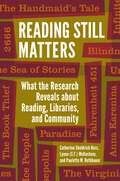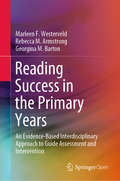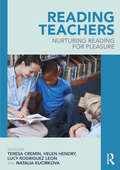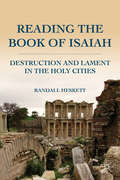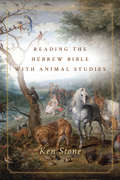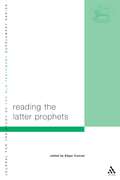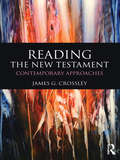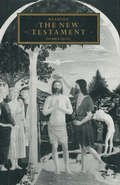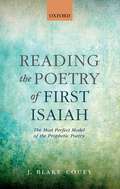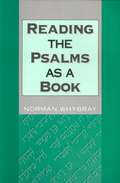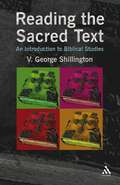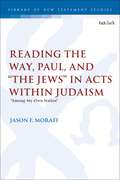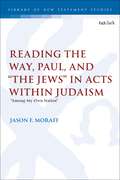- Table View
- List View
Reading Still Matters: What the Research Reveals about Reading, Libraries, and Community
by Catherine Sheldrick Ross Lynne (E.F.) McKechnie Paulette M. RothbauerDrawing on scholarly research findings, this book presents a cogent case that librarians can use to work towards prioritization of reading in libraries and in schools.Reading is more important than it has ever been—recent research on reading, such as PEW reports and Scholastic's "Kids and Family Reading Report," proves that fact. This new edition of Reading Matters provides powerful evidence that can be used to justify the establishment, maintenance, and growth of pleasure reading collections, both fiction and nonfiction, and of readers' advisory services. The authors assert that reading should be woven into the majority of library activities: reference, collection building, provision of leisure materials, readers' advisory services, storytelling and story time programs, adult literacy programs, and more.This edition also addresses emergent areas of interest, such as e-reading, e-writing, and e-publishing; multiple literacies; visual texts; the ascendancy of young adult fiction; and fan fiction. A new chapter addresses special communities of YA readers. The book will help library administrators and personnel convey the importance of reading to grant-funding agencies, stakeholders, and the public at large. LIS faculty who wish to establish and maintain courses in readers' advisory will find it of particular interest.
Reading Still Matters: What the Research Reveals about Reading, Libraries, and Community
by Catherine Sheldrick Ross Lynne (E.F.) McKechnie Paulette M. RothbauerDrawing on scholarly research findings, this book presents a cogent case that librarians can use to work towards prioritization of reading in libraries and in schools.Reading is more important than it has ever been—recent research on reading, such as PEW reports and Scholastic's "Kids and Family Reading Report," proves that fact. This new edition of Reading Matters provides powerful evidence that can be used to justify the establishment, maintenance, and growth of pleasure reading collections, both fiction and nonfiction, and of readers' advisory services. The authors assert that reading should be woven into the majority of library activities: reference, collection building, provision of leisure materials, readers' advisory services, storytelling and story time programs, adult literacy programs, and more.This edition also addresses emergent areas of interest, such as e-reading, e-writing, and e-publishing; multiple literacies; visual texts; the ascendancy of young adult fiction; and fan fiction. A new chapter addresses special communities of YA readers. The book will help library administrators and personnel convey the importance of reading to grant-funding agencies, stakeholders, and the public at large. LIS faculty who wish to establish and maintain courses in readers' advisory will find it of particular interest.
Reading Students' Lives: Literacy Learning across Time (Expanding Literacies in Education)
by Catherine Compton-LillyReading Students’ Lives documents literacy practices across time as children move through school, with a focus on issues of schooling, identity construction, and how students and their parents make sense of students’ lives across time. The final book in a series of four that track a group of low-income African American students and their parents across a decade, it follows the same children into high school, bringing to the forefront issues and insights that are invisible in shorter-term projects. This is a free-standing volume that breaks new ground both theoretically and methodologically and has important implications for children, schools, and educational research. Its significant contributions include the unique longitudinal nature of the study, the lens it casts on family literacy practices during high school years, the close and situated look at the experiences of children from communities that have been historically underserved by schools, and the factors that alltoooften cause many of these children to move further and further away from school, eventually dropping out or failing to graduate.
Reading Students' Lives: Literacy Learning across Time (Expanding Literacies in Education)
by Catherine Compton-LillyReading Students’ Lives documents literacy practices across time as children move through school, with a focus on issues of schooling, identity construction, and how students and their parents make sense of students’ lives across time. The final book in a series of four that track a group of low-income African American students and their parents across a decade, it follows the same children into high school, bringing to the forefront issues and insights that are invisible in shorter-term projects. This is a free-standing volume that breaks new ground both theoretically and methodologically and has important implications for children, schools, and educational research. Its significant contributions include the unique longitudinal nature of the study, the lens it casts on family literacy practices during high school years, the close and situated look at the experiences of children from communities that have been historically underserved by schools, and the factors that alltoooften cause many of these children to move further and further away from school, eventually dropping out or failing to graduate.
Reading Success for All Students: Using Formative Assessment to Guide Instruction and Intervention
by Thomas G. GunningHelp for reading teachers in continuous monitoring, assessment and instruction that targets students' problem areas This vital resource offers classroom teachers and literacy coaches practical assessments that can be used to evaluate key areas in students' reading performance. These assessments will provide information that can be directly used for planning instruction. Specific instructional techniques and activities are linked to each of the assessments so that teachers know exactly how to teach necessary skills. Tests and other evaluative devices are aligned with Common Core State Standards and state frameworks. Offers a proven model for monitoring and assessing students Assessments and instructional strategies are easy to implement as part of any curriculum Practical strategies are modeled on a tested approach for helping students work through their problem areas
Reading Success for All Students: Using Formative Assessment to Guide Instruction and Intervention
by Thomas G. GunningHelp for reading teachers in continuous monitoring, assessment and instruction that targets students' problem areas This vital resource offers classroom teachers and literacy coaches practical assessments that can be used to evaluate key areas in students' reading performance. These assessments will provide information that can be directly used for planning instruction. Specific instructional techniques and activities are linked to each of the assessments so that teachers know exactly how to teach necessary skills. Tests and other evaluative devices are aligned with Common Core State Standards and state frameworks. Offers a proven model for monitoring and assessing students Assessments and instructional strategies are easy to implement as part of any curriculum Practical strategies are modeled on a tested approach for helping students work through their problem areas
Reading Success in the Early Primary Years: A Teacher's Guide to Implementing Systematic Instruction
by Jocelyn SeamerReading Success in the Early Primary Years is a step-by-step guide to structured literacy instruction for teachers working in the early years of primary school. Written by a teacher, for teachers, this book supports teachers to understand the evidence base of reading instruction and how to successfully implement it. Structured in three parts, the book breaks down complex concepts in a concise, accessible manner, guiding teachers on eight key actions to take to get every child on the path to reading proficiency. These include instruction in phonics, phonological and phonemic awareness, integrated reading and spelling opportunities, and the use of decodable texts. Highly practical, Reading Success in the Early Primary Years offers over 20 explicit instructional routines that teachers can implement in their classrooms and guidance on how to get the most out of instructional time. These practical elements are further supported by a summary of relevant research and theories about how reading develops, including an outline of high impact, explicit teaching that draws on cognitive load theory. Rich with sample lesson plans, tools, and examples from real classrooms, this book allows teachers to get on with the business of teaching reading. This is a must-have resource for all who are responsible for children’s reading instruction in the first three years of school.
Reading Success in the Early Primary Years: A Teacher's Guide to Implementing Systematic Instruction
by Jocelyn SeamerReading Success in the Early Primary Years is a step-by-step guide to structured literacy instruction for teachers working in the early years of primary school. Written by a teacher, for teachers, this book supports teachers to understand the evidence base of reading instruction and how to successfully implement it. Structured in three parts, the book breaks down complex concepts in a concise, accessible manner, guiding teachers on eight key actions to take to get every child on the path to reading proficiency. These include instruction in phonics, phonological and phonemic awareness, integrated reading and spelling opportunities, and the use of decodable texts. Highly practical, Reading Success in the Early Primary Years offers over 20 explicit instructional routines that teachers can implement in their classrooms and guidance on how to get the most out of instructional time. These practical elements are further supported by a summary of relevant research and theories about how reading develops, including an outline of high impact, explicit teaching that draws on cognitive load theory. Rich with sample lesson plans, tools, and examples from real classrooms, this book allows teachers to get on with the business of teaching reading. This is a must-have resource for all who are responsible for children’s reading instruction in the first three years of school.
Reading Success in the Primary Years: An Evidence-Based Interdisciplinary Approach to Guide Assessment and Intervention (Springerbriefs In Education Ser.)
by Marleen F. Westerveld Rebecca M. Armstrong Georgina M. BartonThis open access book describes the Reading Success project, in which a 5-step, assessment-to- intervention process, based on the Simple View of Reading, was used within a primary school setting in Australia to better support those students who struggle with reading. It provides an easily accessible overview of each step of the process involved in implementing this approach and highlights the crucial importance of collaboration between professionals involved in the teaching of reading within a school setting. It focuses on the decision-making processes used, such as rich dialogue with the leadership team and teachers, and shares participants’ perspectives gathered throughout the project. Using case studies, the book describes how the 5-step approach assists in creating detailed profiles of students’ strengths and weaknesses in spoken and written language skills that can be used to guide targeted intervention This book offers valuable insights for educators, speech pathologists, researchers, and pre-service teacher education students interested in the teaching of reading
Reading Teachers: Nurturing Reading for Pleasure
by Teresa Cremin Helen Hendry Lucy Rodriguez Leon Natalia KucirkovaThis engaging text offers primary school educators a principled way forward on their mission to nurture the life-changing habit of reading in childhood. Informed and inspiring, Reading Teachers accessibly demonstrates how teachers who are motivated, engaged and reflective readers themselves, can develop new understandings of reading for pleasure and make a difference to young learners. Drawing on a range of research evidence, including studies on reading teachers, dis/engaged boy readers, student teachers as readers and work with over 150 schools developing communities of readers, this book provides an accessible overview of international research alongside a highly practical classroom focus. Combining the insights of academics with 24 reading teachers in co-authored chapters, the book includes: • Case studies of how practitioners have used research to inform and improve their practice; • ‘In conversation’ dialogues between educators about classroom practice that fosters positive reader identities; • Reflections on the editors own reading habits, practices and histories; • Recommended reading and suggestions of engaging children’s books. Reading Teachers: Nurturing Reading for Pleasure enables practitioners to develop principled practice, helping all children find pleasure and purpose in reading. This book is therefore essential reading for all primary teachers, head teachers, literacy coordinators and trainee teachers.
Reading Teachers: Nurturing Reading for Pleasure
by Teresa Cremin Helen Hendry Lucy Rodriguez Leon Natalia KucirkovaThis engaging text offers primary school educators a principled way forward on their mission to nurture the life-changing habit of reading in childhood. Informed and inspiring, Reading Teachers accessibly demonstrates how teachers who are motivated, engaged and reflective readers themselves, can develop new understandings of reading for pleasure and make a difference to young learners. Drawing on a range of research evidence, including studies on reading teachers, dis/engaged boy readers, student teachers as readers and work with over 150 schools developing communities of readers, this book provides an accessible overview of international research alongside a highly practical classroom focus. Combining the insights of academics with 24 reading teachers in co-authored chapters, the book includes: • Case studies of how practitioners have used research to inform and improve their practice; • ‘In conversation’ dialogues between educators about classroom practice that fosters positive reader identities; • Reflections on the editors own reading habits, practices and histories; • Recommended reading and suggestions of engaging children’s books. Reading Teachers: Nurturing Reading for Pleasure enables practitioners to develop principled practice, helping all children find pleasure and purpose in reading. This book is therefore essential reading for all primary teachers, head teachers, literacy coordinators and trainee teachers.
The Reading Teacher's Book of Lists (J-B Ed: Book of Lists)
by Edward B. Fry Jacqueline E. KressThe essential handbook for reading teachers, now aligned with the Common Core The Reading Teacher's Book of Lists is the definitive instructional resource for anyone who teaches reading or works in a K-12 English language arts-related field. Newly revised and ready for instant application, this top seller provides up-to-date reading, writing, and language content in more than 240 lists for developing targeted instruction, plus section briefs linking content to research-based teaching practices. This new sixth edition includes a guide that maps the lists to specific Common Core standards for easy lesson planning, and features fifty brand-new lists on: academic and domain-specific vocabulary, foundation skills, rhyming words, second language development, context clues, and more. This edition also includes an expanded writing section that covers registers, signal and transition words, and writers' craft. Brimming with practical examples, key words, teaching ideas, and activities that can be used as-is or adapted to students' needs, these lists are ready to differentiate instruction for an individual student, small-group, or planning multilevel instruction for your whole class. Reading is the center of all school curricula due to recent state and federal initiatives including rigorous standards and new assessments. This book allows to you skip years of curating content and dive right into the classroom armed with smart, relevant, and effective plans. Develop focused learning materials quickly and easily Create unit-specific Common Core aligned lesson plans Link classroom practice to key research in reading, language arts and learning Adapt ready-made ideas to any classroom or level It's more important than ever for students to have access to quality literacy instruction. Timely, up to date, and distinctively smart, The Reading Teacher's Book of Lists should be on every English language arts teacher's desk, librarian's shelf, literacy coach's resource list, and reading professor's radar.
The Reading Teacher's Book of Lists (J-B Ed: Book of Lists)
by Jacqueline E. Kress Edward B. FryThe essential handbook for reading teachers, now aligned with the Common Core The Reading Teacher's Book of Lists is the definitive instructional resource for anyone who teaches reading or works in a K-12 English language arts-related field. Newly revised and ready for instant application, this top seller provides up-to-date reading, writing, and language content in more than 240 lists for developing targeted instruction, plus section briefs linking content to research-based teaching practices. This new sixth edition includes a guide that maps the lists to specific Common Core standards for easy lesson planning, and features fifty brand-new lists on: academic and domain-specific vocabulary, foundation skills, rhyming words, second language development, context clues, and more. This edition also includes an expanded writing section that covers registers, signal and transition words, and writers' craft. Brimming with practical examples, key words, teaching ideas, and activities that can be used as-is or adapted to students' needs, these lists are ready to differentiate instruction for an individual student, small-group, or planning multilevel instruction for your whole class. Reading is the center of all school curricula due to recent state and federal initiatives including rigorous standards and new assessments. This book allows to you skip years of curating content and dive right into the classroom armed with smart, relevant, and effective plans. Develop focused learning materials quickly and easily Create unit-specific Common Core aligned lesson plans Link classroom practice to key research in reading, language arts and learning Adapt ready-made ideas to any classroom or level It's more important than ever for students to have access to quality literacy instruction. Timely, up to date, and distinctively smart, The Reading Teacher's Book of Lists should be on every English language arts teacher's desk, librarian's shelf, literacy coach's resource list, and reading professor's radar.
Reading Test - Year 3 (PDF)
by Catherine CaseyCheck your child's progress with these new format National Curriculum SATs tests. These practice tests are designed to check children's level of understanding at the end of Year 3. Each pack comes with three complete practice tests (test papers and corresponding reading booklets), and an accompanying Guidance and Mark Scheme booklet. These practice tests have a similar look and feel to the new Key Stage 2 reading SATs test, to help familiarise children with both the content and format of these tests. The tests can be used to track progress in school, but can also be used in the home. The guidance and mark scheme provides advice for parents and carers on how to use the tests and how to support children in preparing for them. Scholastic National Curriculum Revision: Year 3 is also available, offering children the opportunity to check their progress across the English curriculum and to develop the skills they need for these national tests.
Reading the Book of Isaiah: Destruction and Lament in the Holy Cities
by R. HeskettRandall Heskett uses both historical criticism and a form-critical approach to analyze and assess Lamentation and Restoration of Destroyed Cities as oral traditions of ancient Israelite prophetic genres.
Reading the Hebrew Bible with Animal Studies
by Ken StoneAnimal studies may be a recent academic development, but our fascination with animals is nothing new. Surviving cave paintings are of animal forms, and closer to us, as Ken Stone points out, animals populate biblical literature from beginning to end. This book explores the significance of animal studies for the interpretation of the Hebrew Bible. The field has had relatively little impact on biblical interpretation to date, but combined with biblical scholarship, it sheds useful light on animals, animal symbolism, and the relations among animals, humans, and God—not only for those who study biblical literature and its ancient context, but for contemporary readers concerned with environmental, social, and animal ethics. Without the presence of domesticated and wild animals, neither biblical traditions nor the religions that make use of the Bible would exist in their current forms. Although parts of the Bible draw a clear line between humans and animals, other passages complicate that line in multiple ways and challenge our assumptions about the roles animals play therein. Engaging influential thinkers, including Jacques Derrida, Donna Haraway, and other experts in animal and ecological studies, Reading the Hebrew Bible with Animal Studies shows how prehumanist texts reveal unexpectedly relevant dynamics and themes for our posthumanist age.
Reading the Latter Prophets: Toward a New Canonical Criticism (The Library of Hebrew Bible/Old Testament Studies)
by Edgar W. ConradEdgar W. Conrad focuses on the prophetic books as composite collections and shows that (1) prophets are characters in the text, depicted as figures of the past whose words are significant for a later time; (2) reading and writing play a central role in the depiction of prophets; (3) prophetic books are presented as written words available to later generations through reading; (4) that read as a whole, the latter prophets depict the end of prophecy and the emergence of messengers of the Lord.Reading the Latter Prophets is an important contribution to the problems of both the formation and function of the prophetic literature.
Reading the New Testament: Contemporary Approaches
by James G. CrossleyReading the New Testament offers an exciting and contemporary approach to New Testament Studies, which have changed dramatically in the past thirty years. James Crossley combines an introduction to traditional methods of source, form and social-scientific criticism with postcolonial, gender and political frameworks. He discusses reception-history, covering areas such as popular culture, party politics, historical theology and the politics of contemporary scholarship. He discusses Paul and Christian origins in continental philosophy, as well as offering a more traditional analysis of Paul’s theology and the quest for the historical Jesus. A selection of readings from contemporary scholarship is provided in the final chapter of the book. Reading the New Testament has been carefully designed to help students think critically and in wide-ranging ways about the texts of the New Testament and will prove a valuable resource for everyone engaged in serious study of the Bible.
Reading the New Testament: Contemporary Approaches
by James G. CrossleyReading the New Testament offers an exciting and contemporary approach to New Testament Studies, which have changed dramatically in the past thirty years. James Crossley combines an introduction to traditional methods of source, form and social-scientific criticism with postcolonial, gender and political frameworks. He discusses reception-history, covering areas such as popular culture, party politics, historical theology and the politics of contemporary scholarship. He discusses Paul and Christian origins in continental philosophy, as well as offering a more traditional analysis of Paul’s theology and the quest for the historical Jesus. A selection of readings from contemporary scholarship is provided in the final chapter of the book. Reading the New Testament has been carefully designed to help students think critically and in wide-ranging ways about the texts of the New Testament and will prove a valuable resource for everyone engaged in serious study of the Bible.
Reading the New Testament
by Patrick GrantRecent literary criticism and biblical scholarship are used here to discuss the New Testament's depiction of faith. The author argues that these tools can be used to present problems of religious belief imaginatively, and to bring home the full challenge of faith.
Reading the Poetry of First Isaiah: The Most Perfect Model of the Prophetic Poetry
by J. Blake CoueyReading the Poetry of First Isaiah provides a literary and historical study of the prophetic poetry of First Isaiah, an underappreciated but highly sophisticated collection of poems in the Hebrew Bible. Informed by recent developments in biblical studies and broader trends in the study of poetry, Dr J. Blake Couey articulates a fresh account of Biblical Hebrew poetry and argues that careful attention to poetic style is crucial for the interpretation of these texts. Discussing lineation, he explains that lines serve important rhetorical functions in First Isaiah, but the absence of lineated manuscripts from antiquity makes it necessary to defend proposed line divisions using criteria such as parallelism, rhythm, and syntax. He examines poetic structure, and highlights that parallelism and enjambment create a sense of progression between individual lines, which are tightly joined to form couplets, triplets, quatrains, and occasionally even longer groups. Later, Dr Couey treats imagery and metaphor in First Isaiah. A striking variety of images-most notably agricultural and animal imagery-appear in diverse contexts in these poems, often with rich figurative significance.
Reading the Psalms as a Book (The Library of Hebrew Bible/Old Testament Studies)
by R. Norman WhybrayThis book discusses the theory that the Psalter was compiled with the specific intention that it should be used as a book for private spiritual reading. It is argued that if this were so, the work of the final editors would not have been confined to arranging the psalms in a particular order but would have included additions and interpolations intended to give the whole book a new orientation. An investigation of selected psalms shows that although the Psalter may have become a book for private devotion not long after its compilation, there is little evidence that it was compiled for that purpose.
Reading the Sacred Text: An Introduction in Biblical Studies
by V. George ShillingtonA comprehensive manual for anyone wishing to become competent in reading and understanding the Scriptures of the Judeo-Christian tradition.The chapters of this book introduce the reader to all aspects of biblical studies. They guide the reader through the maze, from 'Venturing In' to 'Negotiated Reading'. There are sections on, for example, considering the self-consciousness of the reader/interpreter, the interaction of the tradition with the text of Scripture through the ages, the various literary genres together with the principal forms within the larger biblical documents, ways of reading the text in the modern and post-modern periods, how the academic reading of Scripture and the church reading interact, the relation between competent reading of the sacred text and the preparation and delivery of the sermon, the place of dialogue in the interpretive process.The conclusion sums up the discussion throughout the book and focuses the issues for a competent reading of the Bible and related writings.Student-friendly features include, at the end of each chapter:--An Objective, summarizing the content and objective of the chapter12-14 lead questions with act as in-depth study exercises--Full bibliography and suggestions for further reading
Reading the Way, Paul, and “The Jews” in Acts within Judaism: “Among My Own Nation” (The Library of New Testament Studies)
by Dr. Jason F. MoraffJason F. Moraff challenges the contention that Acts' sharp rhetoric and portrayal of “the Jews” reflects anti-Judaism and supersessionism. He argues that, rather than constructing Christian identity in contrast to Judaism, Acts binds the Way, Paul, and “the Jews” together into a shared identity as Israel, and that together they embark on a journey of repentance with common Jewishness providing the foundation. Acts leverages Jewish kinship, language, cult, and custom to portray the Way, Paul, and “the Jews” as one family debating the direction of their ancestral tradition. Using a historically situated narrative approach, Moraff frames Acts' portrayal of the Way and Paul in relation to the Jewish people as participating in internecine conflict regarding the Jewish tradition-in-crisis, after the destruction of the temple. By exploring ancient ethnicity, Jewish identity and Lukan characterization, images of the Jews, the Way, and Paul, violence in Acts and the theme of blindness in Luke's gospel, the Pauline writings and Acts, Moraff stresses that Acts speaks from “among my own nation,” meaning “the Jews”, and makes it possible to understand Acts' critical characterization of “the Jews” within Second Temple Judaism.
Reading the Way, Paul, and “The Jews” in Acts within Judaism: “Among My Own Nation” (The Library of New Testament Studies)
by Dr. Jason F. MoraffJason F. Moraff challenges the contention that Acts' sharp rhetoric and portrayal of “the Jews” reflects anti-Judaism and supersessionism. He argues that, rather than constructing Christian identity in contrast to Judaism, Acts binds the Way, Paul, and “the Jews” together into a shared identity as Israel, and that together they embark on a journey of repentance with common Jewishness providing the foundation. Acts leverages Jewish kinship, language, cult, and custom to portray the Way, Paul, and “the Jews” as one family debating the direction of their ancestral tradition. Using a historically situated narrative approach, Moraff frames Acts' portrayal of the Way and Paul in relation to the Jewish people as participating in internecine conflict regarding the Jewish tradition-in-crisis, after the destruction of the temple. By exploring ancient ethnicity, Jewish identity and Lukan characterization, images of the Jews, the Way, and Paul, violence in Acts and the theme of blindness in Luke's gospel, the Pauline writings and Acts, Moraff stresses that Acts speaks from “among my own nation,” meaning “the Jews”, and makes it possible to understand Acts' critical characterization of “the Jews” within Second Temple Judaism.
